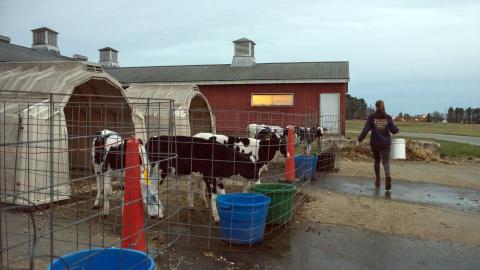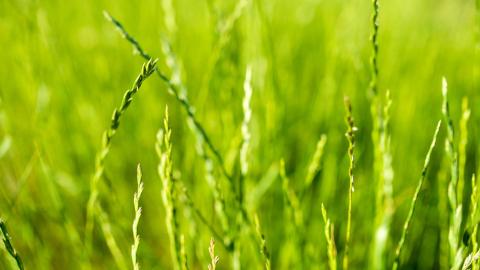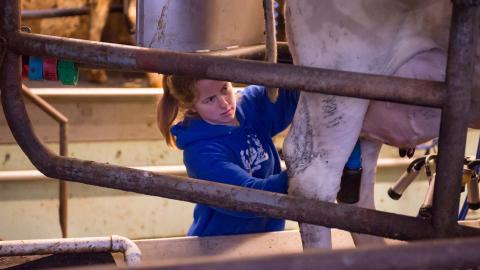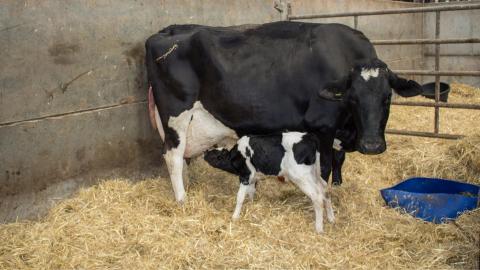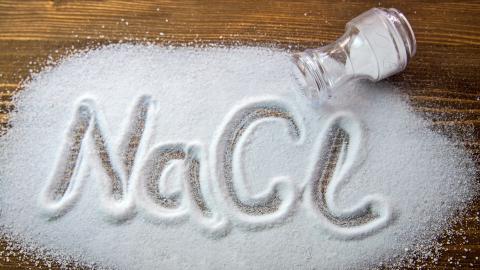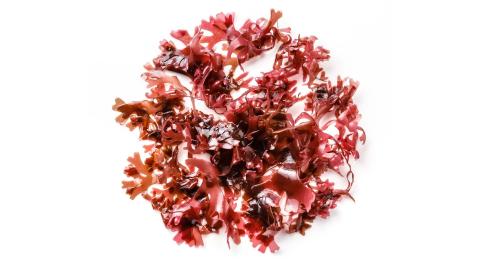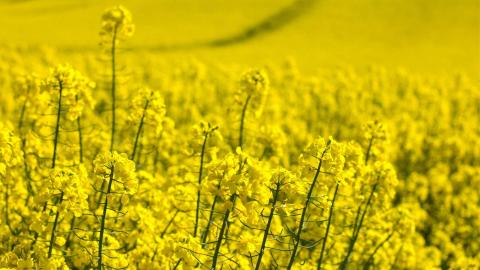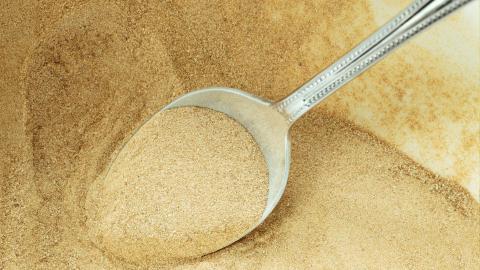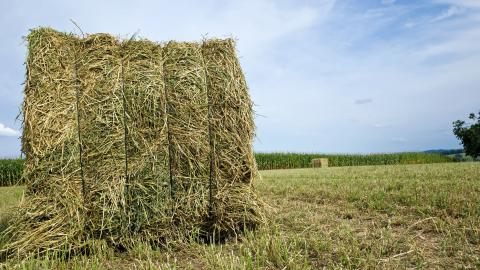NHAES INSPIRED Dairy Report, Winter 2021
We are delighted to share with you the latest research from our colleagues at the University of New Hampshire. The briefs in this report cover a diverse set of issues facing the dairy sector in the Granite State and northern New England. The topics range from feed production strategies, to feed additive assessments, calf health and methane emission reduction to name just a few. Each piece offers a snapshot of the rigorous science as well as the practical takeaways that can make individual dairy operations and the collective industry more economically resilient and environmentally sustainable. Read and download a pdf version of the entire publication below, or check out the individual Inspired Dairy research articles below. And sign up for the NHAES newsletter to receive the latest updates on future editions of the Inspired research report.
Certain cultivars of perennial ryegrass (Lolium perenne L.) can provide some of the highest quality forage in addition to being productive and easy to establish. NHAES researchers revisited research conducted several years ago to evaluate what traits contributed to ryegrass productivity and longevity and to better assess whether perennial ryegrass is a good choice for N.H. producers.
Mycotoxins are toxic compounds naturally produced by certain types of molds and pose a serious risk to both humans and animals. When feed is high in mycotoxin contamination, the overall health and production of dairy cattle are adversely impacted. Two trials were conducted to measure the effect of a mycotoxin deactivator binder, which can negate the toxic effects on lactating dairy cattle when fed a diet high in mycotoxin contamination.
Lysine (Lys) and methionine (Met) are the two most limiting amino acids (AAs) in typical North American dairy diets. Several rumen-protected Lys (RP-Lys) and rumen-protected methionine (RP-Met) feed supplements are available, however, successful use of rumen protected AA products requires accurate and reliable estimates of AA bioavailability because these nutrients are expensive. This study refines the plasma-free dose response technique to get reliable estimates of relative bioavailability of RP-AA supplements.
Dairy farmers have been using direct-fed microbials (DFMs) for several years in the feeding of dairy cattle. Results include increased feed intake, reduced incidence of ketosis and increased blood antibody concentrations. However, few studies consider the effect of the enzymes cellulases and amylases—with bacteria and yeast supplementation—on colostrum quality and yield, which this research does.
Colostrum is essential for calf health from the increase in protein content (antibodies and growth factors). However, about 60% of the colostrum produced in the United States fails to meet quality standards. Since nicotinic acid increases blood flow and potentially rumen bacteria growth, adding this to the diet of dry cows could enhance the quality of colostrum for calves. This research examines that hypothesis.
Calving can be a stressful time, especially in calves that experience a difficult birth. When a calf experiences dystocia due to stress and potential hypoxia, immunoglobulin (Ig) absorption can be compromised. The NSAID meloxicam has been shown to improve calf vigor, milk intake, weight gain and health. This study evaluated adding meloxicam to a colostrum-based colostrum replacer.
Raising replacement heifers is one of the largest expenses on the farm. Thus, it is important to closely manage young-stock with adequate nutrition to ensure those animals reach developmental maturity. Scientists found that sodium butyrate is an adequate replacement for monensin in the diets of post-weaned heifers for both growth and reduction in coccidiosis. This research looks at if sodium butyrate could potentially be fed from birth to first calving for increased nutrient use, growth and improved health.
Enteric fermentation (fermentation taking place in the digestive system of animals) by ruminants is the largest source of methane emissions in the US (approximately 25% of total methane emissions). Recently, algae-based feeds have gained attention because they may be able to not only suppress methane emissions, but also to improve animal feed efficiency. This study evaluated how incremental increases of the seaweed Chondrus crispus affects milk and methane production in organic dairy cows.
Focus group interviews and surveys indicate that profitable strategies to maximize forage use present a challenge to the majority of organic dairy farmers. Moreover, there's a lack of knowledge about the best annual species and grazing rotations that can lead to higher milk production and farm profitability. This research examined using canola as a forage crop.
It has been a common practice to feed wet brewers' grains to dairy cows, but no data were available indicating how to feed it to post-weaned heifers, however, wet brewers' grains have a propensity to spoil. This research determined how preservation can be increased and whether there are positive or negative effects on performance as compared to heifers fed a conventional diet.
Research has shown that dairy cows fed legume silages consumed more dry matter (DM) and produced more milk than those receiving grass silages. However, across northeastern U.S. dairies, legumes only contributed to 26% of grazed forage. This research looked at which legume-grass mixtures are best suitable for producing profitable milk (i.e., higher butterfat and protein).
Rosenfeld, C.S., and R.M. Roberts. 2004. Maternal diet and other factors affecting offspring sex ratio: A. Review. Biol. Reprod. 71: 1063-1070.
Trivers, R.L., and D.E. Willard. 1973. Natural selection of parental ability to vary the sex ratio of offspring. Science 179: 90-92.
Gallo A., Giuberti G., Frisvad J., Bertuzzi T., and Nielsen K. Review on Mycotoxin Issues in Ruminants: Occurrence in Forages, Effects of Mycotoxin Ingestion on Health Status and Animal Performance and Practical Strategies to Counteract Their Negative Effects. 2015;7(8):3057–3111.
Logrieco, A.F. et al. The Mycotox Charter: Increasing Awareness of, and Concerte Action for, Minimizing Mycotoxin Exposure Worldwide. Toxins vol. 10,4 149. 4 Apr. 2018, doi:10.3390/toxins10040149
USDA. Fungal Diseases and Mycotoxin Reference. GIPSA. Washington D.C. 2016.
Whitlow, L.W., and W.M. Hagler. "Mycotoxin Contamination of Feedstuffs – An AdditionalStress Factor for Dairy Cattle.” North Carolina State University, projects.ncsu.edu/cals/an_sci/extension/dairy/mycoto~1.pdf.
Berthiaume, R., H. Lapierre, M. Stevenson, N. Cote, and B.W. McBride. 2000. Comparison of the in situ and in vivo intestinal disappearance of ruminally protected methionine. J. Dairy Sci. 83:2049-2056.
Ji, P., H.A. Tucker, R.E. Clark, M. Miura, and C.S. Ballard. 2015. Short communication: Effect on on-farm feeding practices on rumen protected lysine products. J. Dairy Sci. 99:1242-1246.
Lee, C., A.N. Hristov, T.W. Cassidy, K.S. Heyler, H. Lapierre, G.A. Varga, M.J. de Veth, R.A. Patton, and C. Parys. 2012. Rumen protected lysine, methionine, and histidine increase milk protein yield in dairy cows fed a metabolizable protein-deficient diet. J. Dairy Sci. 95:6042–6056.
Rulquin, H., P.M. Pisulewski, R. Verite, and J. Guinard. 1993. Milk production and composition as function of postruminal lysine and methionine supply: A nutrient-response approach. Livest. Prod. Sci. 37:69–90.
Schwab, C.G., C.K. Bozak, N.L. Whitehouse, and M.M.A. Mesbah. 1992a. Amino acid limitation and flow to the duodenum at four stages of lactation sequence of lysine and methionine limitation. J. Dairy Sci. 75:3486-3502.
Schwab, C.G., C.K. Bozak, N.L. Whitehouse, and V.M. Olson. 1992b. Amino acid limitation and flow to the duodenum at four stages of lactation. II. Extent of lysine limitation. J. Dairy Sci. 75:3503-3518.
Ort, S.B., K.M. Aragona, C.E. Chapman, E. Shangraw, A.F. Brito, D.J. Schauff, and P.S. Erickson. 2018. The impact of direct-fed microbials and enzymes on the health and performance of dairy cows with emphasis on colostrum quality and serum immunoglobulin concentrations in calves. J. Anim. Physiol. Anim. Nutr. 102: e641-e652.
Aragona, K.M., E.M. Rice, M. Engstrom, and P.S. Erickson. 2020. Supplementation of nicotinic acid to prepartum Holstein cows increases colostral immunoglobulin G, excretion of urinary purine derivatives, and feed efficiency in calves. J. Dairy Sci. 103:2287-2302.
Using an NSAID in Newborn Calves: Effects on IgG Uptake and Preweaning Calf Performance
Clark, M.O.C., T.C. Stahl, and P.S. Erickson. 2020. The effect of meloxicam on neonatal dairy calves: Immunoglobulin G uptake and preweaning performance. J. Dairy Sci. 103:11363-11374.
Murray, C. F., T. F. Duffield, D. B. Haley, D. L. Pearl, D. M. Veira, S. M. Deelen, and K. E. Leslie. 2015a. The effect of meloxicam NSAID therapy on the change in vigor, suckling reflex, blood gas measures, milk intake, and other variables in newborn dairy calves. J. Vet. Sci. Anim. Husb. 4:1–14.
Murray, C. F., D. B. Haley, T. F. Duffield, D. L. Pearl, S. M. Deelen, and K. E. Leslie. 2015b. A field study to evaluate the effects of meloxicam NSAID therapy and calving assistance on newborn calf vigor, improvement of health and growth in pre-weaned Holstein calves. Bov. Pract. 49:1–12.
Murray, C. F., D. M. Veira, A. L. Nadalin, D. M. Haines, M. L. Jackson, D. L. Pearl, and K. E. Leslie. 2015c. The effect of dystocia on physiological and behavioral characteristics related to vitality and passive transfer of immunoglobulins in newborn Holstein calves. Can. J. Vet. Res. 79:109–119.
Rice, E.M., K.M. Aragona, S.C. Moreland, and P.S. Erickson. 2019. Supplementation of sodium butyrate to postweaned heifer diets: Effects on growth performance, nutrient digestibility, and health. J. Dairy Sci. 102: 3121–3130.
Stahl, T.C., E. Hatungimana, K.D. Klanderman, S.C. Moreland, and P.S. Erickson. 2020. Sodium butyrate and monensin supplementation to post-weaned heifer diets: Effects on growth performance, nutrient digestibility, and health. J. Dairy Sci. 103:10207–10218.
Antaya, N. T., K. J. Soder, J. Kraft, N. L. Whitehouse, N. E. Guindon, P. S. Erickson, A. B. Conroy, and A. F. Brito. 2015. Incremental amounts of Ascophyllum nodosum meal do not improve animal performance but do increase milk iodine output in early lactation dairy cows fed high-forage diets. J. Dairy Sci. 98:1991–2004.
L. Machado, M. Magnusson, N. A. Paul, R. de Nys, and N. Tomkins. 2014. Effects of marine and freshwater macroalgae on in vitro total gas and methane production. PLoS ONE 9: e85289.
Hardie, C. A., M. Wattiaux, M. Dutreuil, R. Gildersleeve, N. S. Keuler, and V. E. Cabrera. 2014. Feeding strategies on certified organic dairy farms in Wisconsin and their effect on milk production and income over feed costs. J. Dairy Sci. 97:4612–4623.
S. L. Dillard, A. I. Roca-Fernández, M. D. Rubano, K. R. Elkin, and K. J. Soder. 2018. Enteric methane production and ruminal fermentation of forage brassica diets fed in continuous culture. J. Anim. Sci. 2018.96:1362–1374.
Sun, X., G. Henderson, F. Cox, G. Molano, S. J. Harrison, D. Luo, P. H. Janssen, and D. Pacheco. 2015. Lambs fed fresh winter forage rape (Brassica napus L.) emit less methane than those fed perennial ryegrass (Lolium perenne L.) and possible mechanisms behind the difference. PLoS ONE. 10:e0119697.
EPA. 2019. Global Non-CO2 Greenhouse Gas Emission Projections and Mitigation: 2015-2050. EPA-430-R-19-010. Available online at: https://www.epa.gov/sites/production/files/2019-09/documents/epa_non-co2_greenhouse_gases_rpt-epa430r19010.pdf (accessed November 10, 2021).
Hatungimana. E., and P.S. Erickson. 2019. Effects of storage of wet brewers' grains treated with salt or a commercially available preservative on the prevention of spoilage, in vitro and in situ dry matter digestibility, and intestinal protein digestibility. Applied Animal Science 35:464-475.
Hatungimana, E. T.C. Stahl, and P.S. Erickson. 2021. Effect of storage of wet brewers' grains with incremental levels of salt on apparent total tract nutrient digestibility and purine derivative excretion in dairy heifers. J. Anim. Sci. 99:1-8.
Hatungimana, E., T.C. Stahl, and P.S. Erickson. 2020. Growth performance and apparent total tract nutrient digestibility of limit-fed diets containing wet brewers' grains to Holstein heifers. Transl. Anim. Sci. 4:1-12.
G. A. Broderick, R. P. Walgenbach, and E. Sterrenburg. 2000. Performance of lactating dairy cows fed alfalfa or red clover silage as the sole forage. J. Dairy Sci. 83:1543–1551.
G. A. Broderick, A. F. Brito, and J. J. Olmos Colmenero. 2007. Effects of feeding formate-treated alfalfa silage or red clover silage on the production of lactating dairy cows. J. Dairy Sci. 90:1378–1391.
M. Johansen, P. Lund, and M. R. Weisbjerg. 2018. Feed intake and milk production in dairy cows fed different grass and legume species: a meta-analysis. Anim. 12: 66–75.
